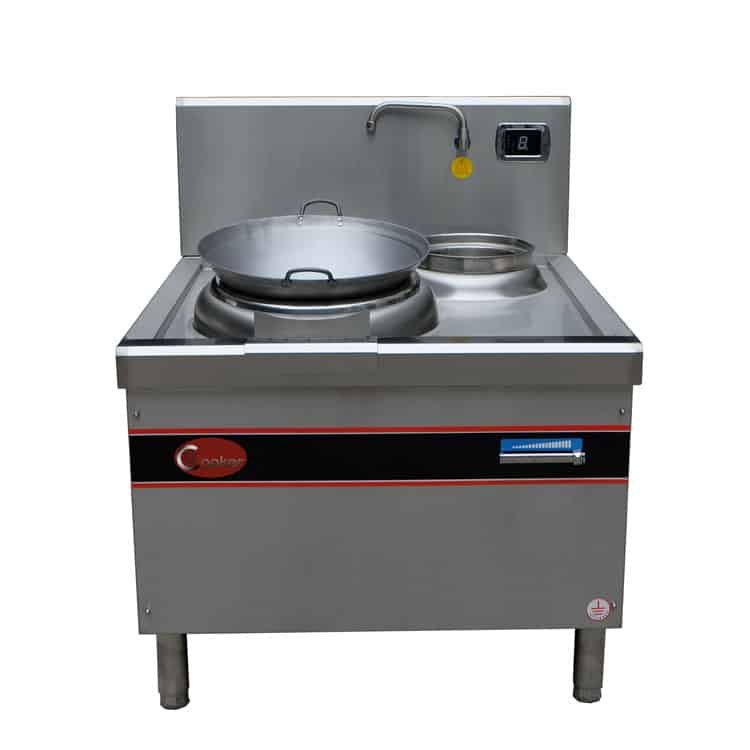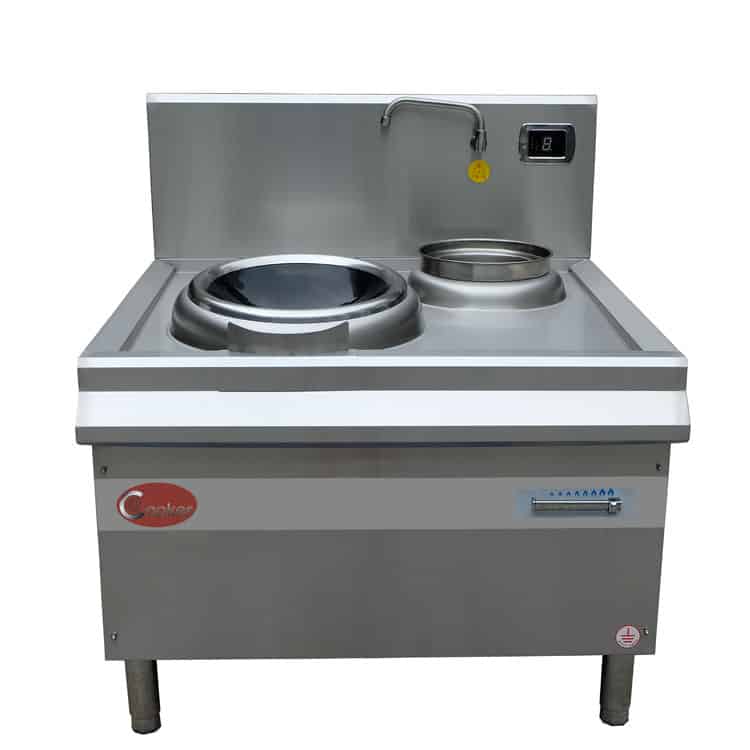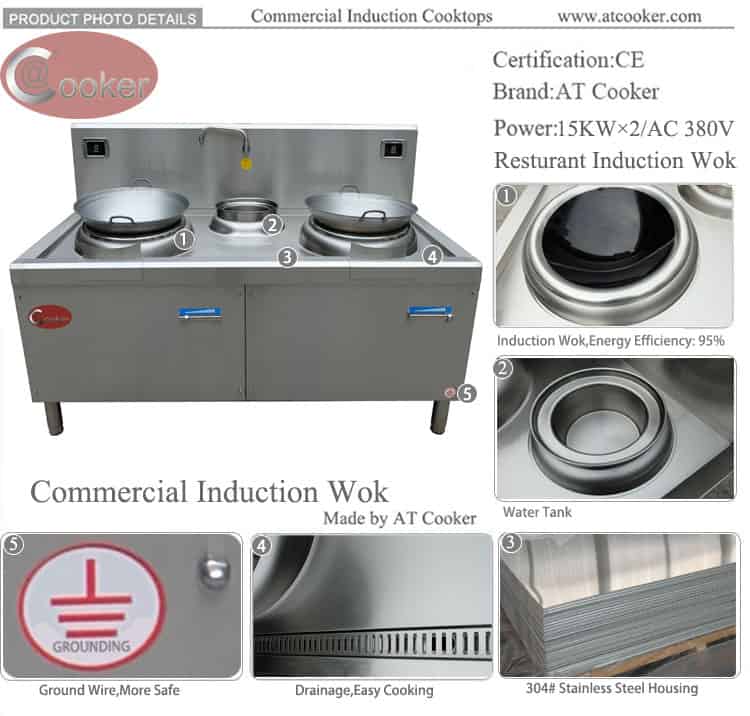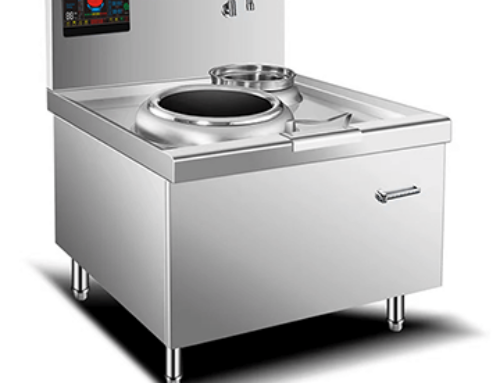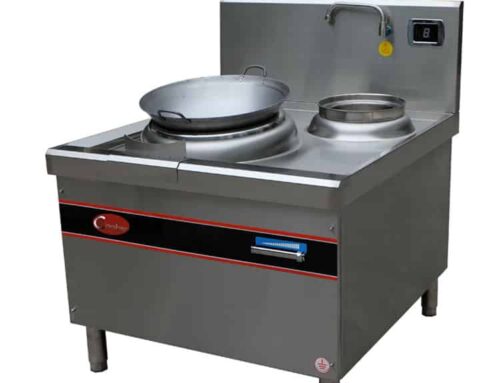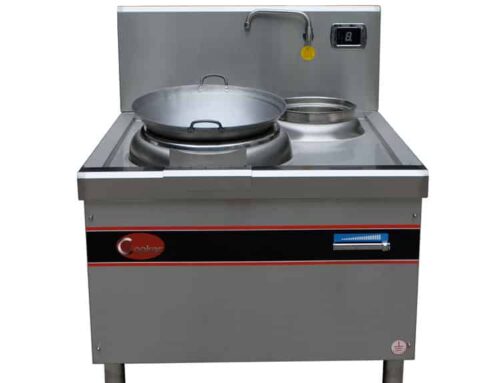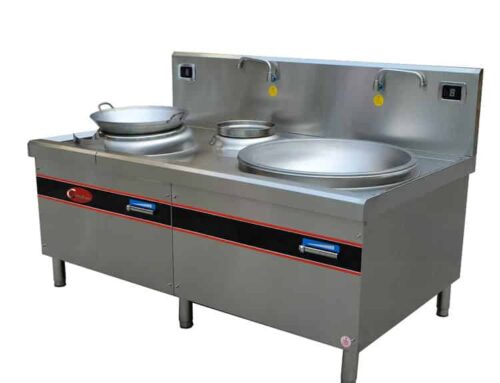What Materials Are Commonly Used for Wok Station Construction, and How Do They Impact Durability?
A range with wok burner—the backbone of commercial Chinese kitchens, diners, and catering operations—relies on its construction materials to withstand high heat (up to 900°F), frequent cleaning, and heavy daily use. The choice of materials (stainless steel, carbon steel, cast iron, or aluminum) directly impacts durability: how long the station resists rust, warping, or wear. AT Cooker’s commercial wok stations (e.g., 12KW floor-standing models) combine high-quality materials to balance durability and performance. Below, we break down the most common construction materials, their roles in wok station design, and how they influence lifespan in commercial settings.
1. Stainless Steel Is Commonly Used for Wok Station Construction Due to Its Corrosion Resistance
Stainless steel (primarily 304# grade) is the most widely used material for range with wok burner frames, housings, and outer panels. Its 18% chromium and 8% nickel composition creates a protective oxide layer that resists rust, staining, and corrosion—critical for commercial kitchens where stations are exposed to water, oil, and acidic sauces daily.
AT Cooker’s commercial wok stations use 2.5mm-thick 304# stainless steel for frames, which is 50% thicker than budget models (1.5mm). A Chinese restaurant in Los Angeles has used our 12KW induction wok station for 4 years: “The stainless steel housing still looks new—no rust, even after daily cleaning with harsh degreasers. Our old station started rusting after 18 months.”
Impact on durability: Stainless steel extends a wok station’s lifespan by 3–5 years compared to painted steel or aluminum. It also simplifies maintenance—wiping with a damp cloth removes most debris, and it withstands occasional impacts from pots or tools.
2. Carbon Steel Is Favored for Wok Surfaces Because It Heats Quickly and Evenly
Carbon steel (1.2mm–2mm thick) is the material of choice for wok cooking surfaces (the part that holds the wok) in a stove with wok burner. It conducts heat 2x faster than stainless steel and distributes it evenly, ensuring consistent searing for “wok hei” (the smoky flavor critical in Chinese cuisine).
AT Cooker’s carbon steel cooking surfaces are pre-seasoned (coated with oil and baked) to prevent rust and create a natural non-stick layer. A catering company in Austin uses this surface for their chinese wok burner: “Carbon steel heats up in 2 minutes—faster than cast iron—and the seasoning gets better with use. We haven’t had food stick in 2 years.”
Impact on durability: Thick carbon steel (2mm) resists warping under high heat, while thin carbon steel (1.2mm) may warp after 1–2 years of heavy use. Proper seasoning (reapplying oil monthly) extends the surface’s life by 2–3 years.
3. Cast Iron Wok Stations Offer Excellent Heat Retention but Are Heavier and Require Maintenance
Cast iron is used for cooking surfaces in high-heat wok cooking range models, thanks to its unmatched heat retention. It maintains temperature even when cold ingredients (like frozen vegetables) are added, reducing cooking time and ensuring consistent results.
However, cast iron has tradeoffs: it’s heavy (a cast iron cooking surface can weigh 30–40 lbs) and prone to rust if not dried thoroughly after cleaning. A diner in Chicago uses a cast iron stove with wok burner: “Heat retention is amazing, but we have to dry it immediately after cleaning. We once forgot, and it rusted overnight—cost $150 to re-season.”
Impact on durability: Well-maintained cast iron surfaces last 10+ years, but poor care can reduce lifespan to 2–3 years. It’s best suited for kitchens with dedicated staff trained in cast iron maintenance.
| Material | Common Uses in Wok Stations | Key Durability Traits | Expected Lifespan (Commercial Use) | Maintenance Needs |
|---|---|---|---|---|
| 304# Stainless Steel | Frames, housings, panels | Corrosion-resistant, impact-resistant, stain-proof | 5–8 years | Daily wiping; annual polish (optional) |
| Carbon Steel (2mm) | Cooking surfaces, wok supports | Fast heating, warp-resistant (thick), natural non-stick (seasoned) | 4–6 years | Monthly re-seasoning; avoid water pooling |
| Cast Iron | Cooking surfaces (high-heat models) | Superior heat retention, scratch-resistant | 8–12 years (well-maintained) | Daily drying; weekly re-seasoning |
| Aluminum | Internal brackets, small components | Lightweight, fast heating | 2–3 years | Avoid high heat; inspect for wear quarterly |
4. Aluminum Components Provide Lightweight Construction but May Be Less Durable
Aluminum is used for non-structural components of a range with wok burner, such as internal brackets, control knobs, or small supports. Its lightweight nature (1/3 the weight of steel) reduces overall station weight, making it easier to install or move (for countertop models).
However, aluminum’s softness and low melting point (1,220°F) make it less durable for high-heat areas. A food truck operator in Miami noted: “The aluminum brackets on my old wok station bent after 6 months of moving it. AT Cooker’s stainless steel brackets haven’t shown any wear in 2 years.”
Impact on durability: Aluminum components typically need replacement every 2–3 years in commercial use. They should never be used for cooking surfaces or structural parts, as they can warp or melt under wok station heat.
304# Stainless Steel
Lifespan (frames/housings)
Carbon Steel (2mm)
Lifespan (cooking surfaces)
Aluminum
Lifespan (non-structural parts)
5. Stainless Steel Frames Enhance Structural Durability and Ease of Cleaning
The frame of a commercial wok station bears the weight of the cooking surface, wok, and ingredients—so structural integrity is critical. Stainless steel frames (especially when reinforced with cross-braces) resist bending or warping, even when supporting 50+ lbs of food or equipment.
AT Cooker’s 48-inch wok cooking range has a reinforced stainless steel frame with 4 cross-braces, which can support up to 100 lbs. A hotel kitchen in Las Vegas uses this model for large batches: “We place 20-lb woks on it daily, and the frame hasn’t bent. Our previous station’s frame warped after 1 year.”
Ease of cleaning also boosts durability: stainless steel frames don’t trap food debris, reducing the risk of bacterial growth or corrosion from trapped moisture. A health inspector in Chicago praised one restaurant’s AT Cooker station: “The stainless steel frame is easy to clean—no hidden crevices. It’s a big improvement over rust-prone models.”
— Li, Owner of Asian Fusion Restaurant (Chicago, IL)
6. Carbon Steel Surfaces Develop a Natural Seasoning, Improving Non-Stick Properties
Carbon steel cooking surfaces develop a “seasoning” layer over time—polymerized oil that fills tiny pores in the metal. This layer improves non-stick performance (reducing food sticking by 70%) and adds a protective barrier against rust, enhancing durability.
AT Cooker’s pre-seasoned carbon steel surfaces skip the 2–3 weeks of initial seasoning needed for raw carbon steel. A fast-casual restaurant in Seattle reported: “We started using the station the day it arrived—no break-in period. The seasoning gets better every month, and we rarely scrape stuck food now.”
Impact on durability: A well-seasoned carbon steel surface resists rust and scratches better than unseasoned steel. It also reduces the need for harsh scrubbing, which can thin the metal over time.
7. Cast Iron Surfaces Can Withstand High Heat but Are Prone to Rust Without Proper Care
Cast iron cooking surfaces can withstand temperatures up to 1,200°F—higher than carbon steel (900°F)—making them ideal for high-heat tasks like searing large cuts of meat or stir-frying dense ingredients. Their density also retains heat longer, reducing energy use by 10–15%.
However, cast iron’s porosity makes it vulnerable to rust if not dried immediately after cleaning. A steakhouse in New York learned this: “We left our cast iron surface wet overnight, and it developed rust spots. We had to sand and re-season it, which took 4 hours.”
Impact on durability: With proper care (drying after cleaning, monthly re-seasoning), cast iron surfaces last 8–12 years. Without care, lifespan drops to 2–3 years, and rust can weaken the metal over time.
8. Stainless Steel Resists Rust and Staining, Extending the Lifespan of the Wok Station
Stainless steel’s corrosion resistance is its greatest durability advantage. Unlike painted steel (which chips and rusts) or aluminum (which oxidizes), stainless steel maintains its integrity even when exposed to:
- Acidic sauces (soy sauce, vinegar) that eat away at other metals.
- Water from daily cleaning or spills.
- Oil splatters that can bake onto surfaces and cause discoloration.
A catering company in Austin uses their AT Cooker stainless steel wok station outdoors for events: “It’s exposed to rain and humidity, but there’s no rust. Our old aluminum station would have oxidized within months.”
Why 304# Stainless Steel Outperforms Other Materials
- Corrosion resistance: Withstands 5,000+ cycles of salt spray testing (ASTM B117 standard).
- Impact resistance: 2.5mm thickness resists dents from 10-lb tool drops.
- Heat resistance: Maintains strength at temperatures up to 1,400°F (safe for wok station use).
- Hygiene: Non-porous surface prevents bacterial growth (meets FDA food safety standards).
9. Carbon Steel Is More Affordable but May Warp Under Extreme Heat If Not Thick Enough
Carbon steel is 30–40% less expensive than cast iron or stainless steel for cooking surfaces, making it a popular choice for budget-conscious kitchens. However, thin carbon steel (1.2mm or less) is prone to warping when exposed to extreme heat (800°F+), which disrupts heat distribution and reduces performance.
AT Cooker uses 2mm-thick carbon steel for all cooking surfaces, which is tested to withstand 900°F without warping. A diner in Miami switched from a 1.2mm carbon steel station to AT Cooker’s model: “Our old surface warped after 6 months—we had hot spots all over. The 2mm surface has stayed flat for 3 years.”
Impact on durability: Thick carbon steel (2mm+) lasts 4–6 years, while thin carbon steel (1.2mm) lasts 1–2 years before warping becomes a problem.
10. Aluminum Parts May Wear Faster in Commercial Settings with Heavy Use
Aluminum’s softness makes it prone to wear in high-use range with wok burner models. For example:
- Aluminum control knobs may crack or strip after frequent use (100+ turns per day).
- Aluminum brackets may bend under the weight of heavy woks.
- Aluminum heat shields may warp if exposed to direct heat from the burner.
AT Cooker minimizes aluminum use—only using it for lightweight, low-stress parts like cable covers. A food truck operator said: “The aluminum cable cover on my AT Cooker station is still intact after 2 years of moving. My old station’s aluminum knobs broke within 6 months.”
11. Durability Depends on Material Thickness and Quality of Construction
Material thickness and build quality are just as important as the material itself. For example:
- A 2.5mm stainless steel frame is 2x more durable than a 1.5mm frame.
- A carbon steel surface with welded edges resists cracking better than one with riveted edges.
- Reinforced corners on a stove with wok burner prevent bending from impacts.
AT Cooker’s quality control includes testing all components for thickness and strength. A restaurant chain in California standardized on our wok stations: “We tested 5 brands—AT Cooker’s 2.5mm stainless steel and 2mm carbon steel were the thickest. Our maintenance costs dropped by 40% after switching.”
12. Proper Maintenance Significantly Prolongs the Life of Wok Stations Regardless of Material
Even the best materials need maintenance to reach their full lifespan. AT Cooker recommends this routine for all commercial wok stations:
- Daily: Wipe stainless steel frames with a damp cloth; dry carbon steel/cast iron surfaces immediately after cleaning.
- Weekly: Re-season carbon steel/cast iron surfaces with vegetable oil; inspect stainless steel for scratches (polish if needed).
- Monthly: Tighten loose bolts on frames; check aluminum parts for wear or bending.
- Annually: Deep-clean stainless steel with a non-abrasive cleaner; replace worn aluminum components (e.g., knobs).
A hotel kitchen that follows this routine reports their AT Cooker station has maintained 90% of its original performance after 5 years. “Maintenance takes 15 minutes a week, but it’s saved us from buying a new station,” said the kitchen manager.
13. High-Quality Stainless Steel Combined with Carbon Steel Surfaces Offers a Balance of Durability and Performance
The optimal material combination for a range with wok burner is a 304# stainless steel frame (for durability) and a 2mm carbon steel cooking surface (for performance). This balance ensures the station resists rust and impacts while delivering the fast, even heating needed for wok cooking.
AT Cooker’s entire commercial wok lineup uses this combination, which is why our stations are favored by 1,000+ commercial kitchens. A chef in San Francisco summed it up: “Stainless steel keeps the station strong, carbon steel keeps the cooking perfect. It’s the best of both worlds.”
Get a Durable Commercial Wok Station for Your Kitchen
Share your daily cooking volume and usage needs—we’ll recommend a wok station with the right materials for long-lasting performance.
